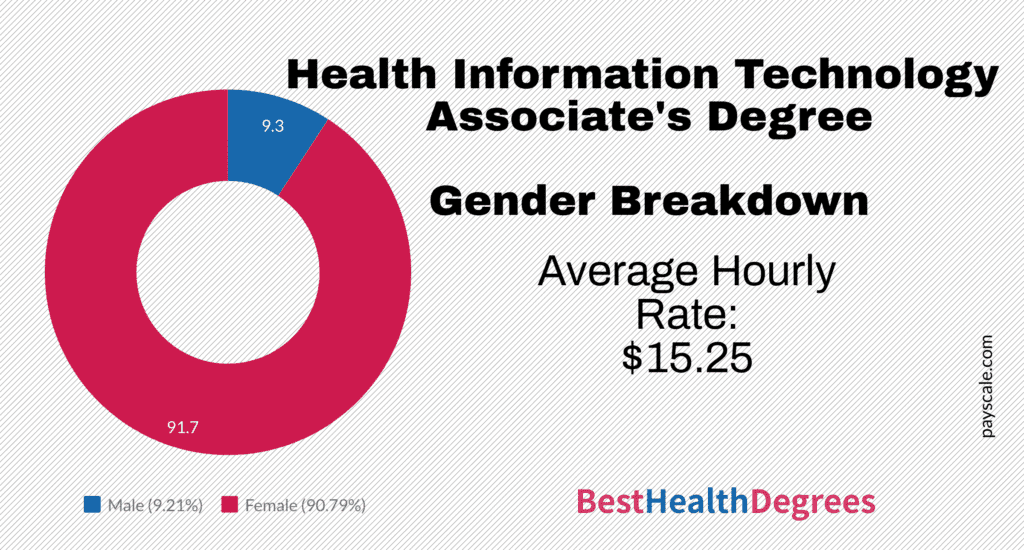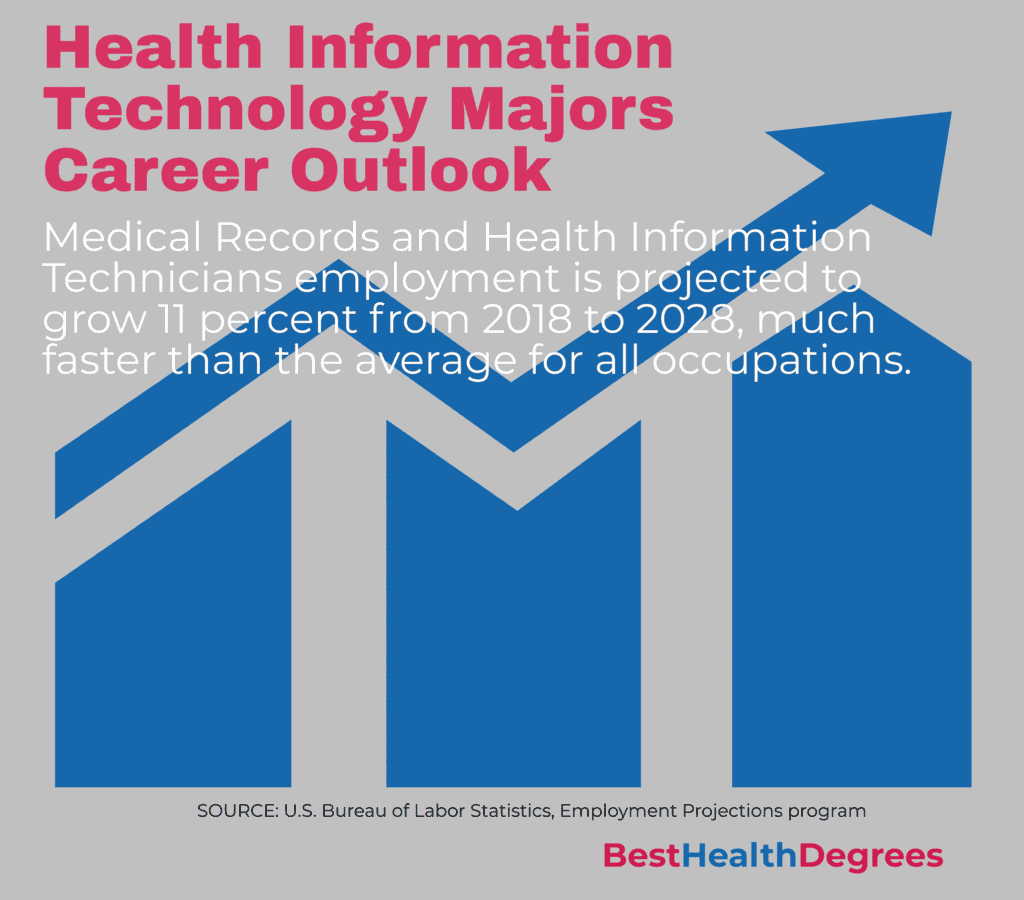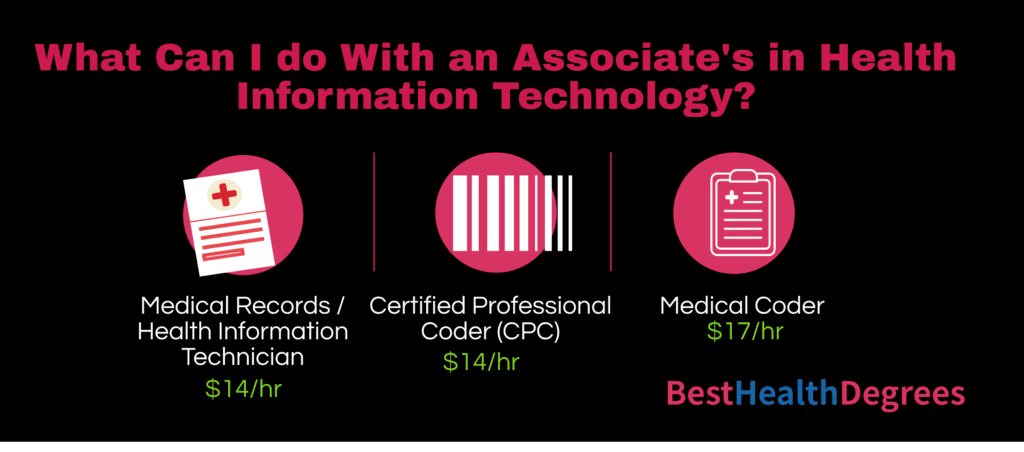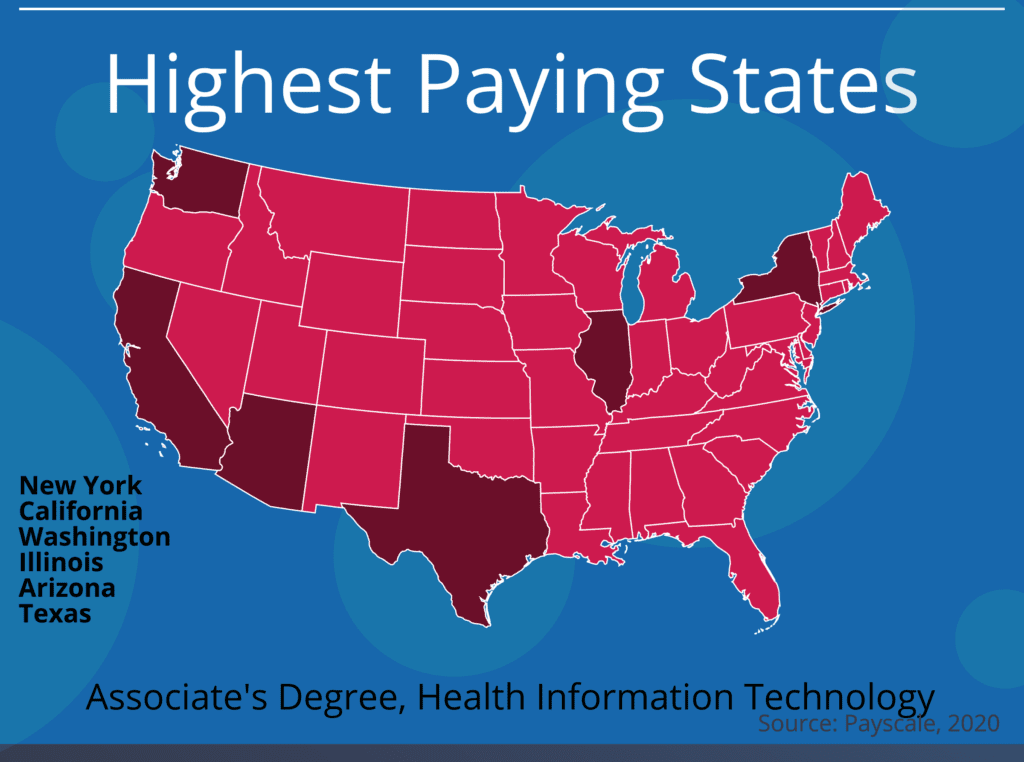Key Takeaways:
- Medical Records Technicians manage patient health data and ensure its accuracy.
- Health Information Technicians specialize in coding and billing for insurance claims.
- Clinical Data Managers handle data for clinical trials and research.
- Health IT Specialists support and maintain electronic health records (EHR) systems.
- These roles are critical in ensuring efficient healthcare delivery and compliance with regulations. HIT careers offer job stability and opportunities for advancement in the growing healthcare industry.
Today’s healthcare requires a lot of hands-on professionals. Some of those professionals, like doctors and nurses, work directly with patients. Others help to keep the medical system up and running. These workers are called allied health workers, and they essentially include any healthcare worker who isn’t a doctor or a nurse.
Allied health professionals enable doctors to focus on their patients. When they keep healthcare facilities running smoothly and maintain medical records, doctors and nurses can rest assured that they have the resources they need for patient care.
Healthcare Information Technicians do this type of important work. Those who work in this field may not get as much recognition as doctors and nurses, but much of the medical system depends on them doing their jobs.

Those who work in Healthcare Information Technology (HIT) work with the digital components of the healthcare world. Among other things, Healthcare Information Technology specialists make sure that electronic medical files stay legal and up to date, process other relevant electronic information as it comes, and perform many other related tasks in healthcare environments. During a typical workday, a Healthcare Information Technician may work with medical billing information, test results, charts, consent forms, and more.
Without HIT specialists, the medical world couldn’t function nearly as well as it does today. It would experience increased delays and stay behind the times. HIT specialists help make sure that patients get the excellent, accurate, and timely care that they deserve.
HIT professionals are important for a lot of reasons, and one of them is the fact that medical technology evolves fast. Someone has to keep up with the rapidly growing medical organization system, including electronic medical records. HIT workers step up to do just that.
Becoming a Healthcare Information Technician starts with getting the right education, which usually means getting an associate’s degree. HIT workers need excellent organizational skills, a grasp of computers and computer systems, and a general knowledge of human anatomy and physiology.
Generally, gaining this knowledge means starting with an associate’s degree, although some HIT specialists do move on to earn a bachelor’s degree once they’ve worked in the field for a few years. If you’re ready to start a career in HIT, you can start by finding a good school. The right college or university can help you get your foot in the door and jumpstart your career. Here’s what you need to know about starting your HIT associate’s degree.
Accreditation for Health Information Technology
How does one choose a HIT program? What sets the best Health Information Technology schools apart from other schools? You’ll probably want to consider a lot of factors, including school size, reputation, location, and affordability.
Before you dive into those factors, though there’s one factor that matters more than everything else. The most important thing is to find an accredited college or university, and checking for accreditation should always be your top priority. The best schools for health information technology will always, without exception, be accredited schools.
When a school is accredited, it means that a qualified third-party accrediting organization has approved and vouched for the school. Accreditation is a stamp of approval telling people that this school provides a good and relevant education.
On the other hand, if a school is not accredited, then its students don’t get that all-important quality assurance. A non-accredited school may provide a decent education, but you’d have no real way of knowing that until you’ve spent a lot of time and money on your classes. A lot of non-accredited schools will take your money and then provide an outdated or irrelevant education. After all, there’s nobody holding them accountable for their material or teaching methods. Many of these programs are glorified scams, even if they have impressive-looking websites.
Potential students should look for accreditation upfront. You can use a few methods to check. The first way is simply to google “Is [school name] accredited?” and see what results you find. Be careful, though, because some non-accredited schools may try to trick you with fancy buzzwords that make them sound “official” to cover their lack of accreditation.
The second way is to visit the school’s website. Most colleges and universities display their accreditation status on their sites. You might not spot a seal of approval right away, but that doesn’t necessarily mean that you’ve found a non-accredited school. Try scrolling to the bottom of the home page, or look for an “accreditation information” option under the “about us” section.
Finally, you can go straight to the source and find the relevant accrediting body. There are several main accrediting organizations for colleges in the United States, all of which are valid and trustworthy. Each one presides over a different set of colleges, depending on region and type. These organizations are:
- Accrediting Commission for Community and Junior Colleges (ACCJC) Western Association of Schools and Colleges
- Higher Learning Commission (HLC)
- Middle States Commission on Higher Education (MSCHE)
- New England Commission on Higher Education (NECHE)
- Northwest Commission on Colleges and Universities (NWCCU)
- Southern Association of Colleges and Schools Commission on Colleges (SACSCOC)
- WASC Senior College and University Commission (WSCUC)
You can look up a school on the corresponding accreditation website for its region, or you can use that accreditation website to verify a school’s claims. For example, if you’re researching a school in Georgia, you should take a look at the SACSCUC first. On the other hand, if you’re looking at schools in Kansas, then the Middle States Commission on Higher Education is your best bet.

Why does school accreditation matter so much? When students look for accreditation first, they can know right away whether or not a school provides a worthwhile experience. You’re going to work hard for your degree, so that degree should be worth something. Plus, accreditation reassures students that their education will be up to date. Remember that medical technology evolves, which means that your education should be able to keep up.
Employers care about accreditation, too. If your resume shows that you went to a non-accredited school, you risk your potential employer rejecting your resume right away. Without attending an accredited school, you may not be able to prove that you have the right training for the job.
You also risk not being prepared for the HIT certification exam, which is something you’ll read about later in this article. As you’ll see later, most HIT employers require certification from their employees, and that certification requires taking a test. However, if you attend a school that teaches outdated or surface-level information, you may not gain the right knowledge for that test.
Finally, consider what may happen in case of transferring schools. When students decide to transfer schools, their classes can only transfer to the next school if the first one is accredited. Without accreditation from the beginning, transfer students may have to start from scratch, putting them behind schedule as they start their careers.
HIT associate’s students who may eventually want a bachelor’s degree should remember this point. When a student earns an associate’s degree from an accredited school, they can apply their associate’s classes to their bachelor’s degree, which can help them save time and money. However, without accreditation from the original school, students can’t apply for those credits.
In many healthcare fields, students should look for both school accreditation and program accreditation. In addition to overall school accreditation, some programs have specific accreditation from an organization that oversees their field.
Now, HIT programs don’t technically require specific accreditation. However, if your potential school has a Healthcare Information Management (HIM) program as well as a HIT program, you might find out if that HIM program is specifically accredited. HIT and HIM are two different parts of the field, but they do overlap. If a school has an accredited HIM program, that accreditation says good things about the school’s healthcare courses in general. The best Health Information Technology programs often exist alongside HIM programs.
HIM accreditation comes from the Commission on Accreditation for Health Informatics and Information Management Education (CAHIIM). You can look up colleges and universities on their website to check for accreditation. You can also check the school program’s web page for information.
All of the above principles apply to online schools, too. Students can get a great HIT education online. Again, though, the best online colleges for Health Information Technology will always be accredited. It’s all too easy for programs to take advantage of eager students online. In fact, it’s much easier to run an online college scam than it is to run an in-person scam, so stay diligent.
On the plus side, it’s just as easy to verify the accreditation status of an online program as it is for an in-person program. Again, start by looking for the information you need on the school’s website.
When looking for the best online school for Health Information Technology, apply all of the same criteria to your search that you would for an in-person program. Whether you want to find the best in-person schools or the best online schools for Health Information Technology, accreditation should always come first.
Types of Health Information Technology Degrees
Compared to some other healthcare degree options, HIT degrees are relatively straightforward. HIT is essentially a standalone career, and it doesn’t necessarily have subcategories in the way that some other professions do.
For aspiring HIT professionals, a health information technology associate degree is often enough to get started in the health information technology field and begin climbing the career ladder. However, after earning that Health Information Technology Associate degree, many students eventually pursue a bachelor’s degree to secure more job opportunities and better salaries.
While earning an associate degree in Health Information Technology, a HIT student will learn anatomy and physiology as well as data, health coding, medical coding, electronic health records, medical data, clinical data, medical terminology, and health information systems. This combination of subjects prepares the student to keep healthcare information and health records organized.
As mentioned above, there’s not a lot of variety within the HIT degree category, which means you won’t have to agonize over that part of the decision. When searching for an associate degree in Health Information Technology, you’ll find two main options: Getting an in-person associate degree in health information technology or getting an online degree in health information technology.
Both options have their pros and cons. With an in-person health information technology associate degree, a student takes classes in a physical classroom with other students. Many of these programs have night class options. On the positive side, these classes work well for those who need lots of structure and face-to-face learning. Plus, when a student asks a question during a face-to-face class, the teacher can answer that question right away.
An in-person health information technology associate degree has drawbacks, though. Most notably, this type of degree doesn’t have a lot of flexibility, so it can be a tough option for people with jobs, families, or other responsibilities.
Now, with online degrees in health information technology, students get the flexibility that they wouldn’t get in person. With health information technology degrees online, students log on to their classes from home or anywhere else they can access the internet. As a matter of fact, some health information technology online degrees don’t have required login times, meaning that students can learn at their own pace.
Online Health Information Technology degrees do have their own drawbacks. One must be disciplined and self-motivated to earn a Health Information Technology degree online. Without the physical structure of a classroom, some students may find difficulty staying motivated.
As you decide which HIT program might work best for you, weigh the pros and cons of both in light of your own needs and learning style.
Health Information Technology Certifications/Licenses
To start a HIT career, you’ll likely need a Health Information Technology certification. While the law doesn’t require this certification to work as a HIT professional, most HIT employers seek job candidates with certification in Health Information Technology. Without certification, a job candidate likely won’t have much luck finding employment, and when they do find employment, they may have to settle for a job that doesn’t quite measure up to their skillset.
The Health Information Technology certificate is called RHIT: the Registered Health Information Technician certification.
Certificates in Health Information Technology require an exam from the American Health Information Management Association (AHIMA). A HIT associate’s program can prepare students for this exam, although further Health Information Technology certifications require a bachelor’s degree.
Although the RHIT exam does require an associate’s education, you can also study for your Health Information Technology certificate online. Some health information technology online certificate programs provide study materials and test-taking tips.
If you’re looking for health information technology certificate programs online, take a look at AHIMA, which offers a list of suggested study resources and an overview of what students may expect from the Health Information Technology Certification exam. These study materials can help you familiarize yourself with test content, and they can help you get used to the format of the exam.
Certificates in Health Information Technology help job seekers get where they need to go. Certification in Health Information Technology can help you stay competitive in the job market, even if you find employers who don’t require Health Information Technology certifications. When employers do require certification, then you’ll have the credentials you’ll need to get a job. In the rare environment that doesn’t require a certificate for Health Information Technology, having that certification can give you an edge.
Certification for Health Information Technology can also give you the same benefit that accreditation provides for colleges; It can let you objectively prove that you have the right skills for the work that you want to do. It’s a shorthand way of saying that you have what it takes to do the work and do it well.
Once you’ve earned your associate’s degree, don’t skip the step of earning your certification in Health Information Technology. Overall, that certification will serve you well in your career.

Careers in Health Information Technology
Jobs in health information technology remain abundant these days, much like jobs in other allied health careers. As a matter of fact, the health information technology job outlook is expected to grow 11% by 2028. Because the need is so high, once you earn your associate’s degree, you’ll have a lot of possible pathways for entry-level health information technology jobs like medical coders. Health information technology careers start here.
Jobs for healthcare technology span across all medical sectors, including hospitals, government organizations, private practices, and more. Some jobs for health information technology are remote jobs, so if you’re looking for health information technology jobs from home, you can find several possibilities. Some jobs in health information technology also involve working in other people’s homes for home health providers.
Now, what jobs are in health information technology? If you do a search for “health information technology jobs near me,” most listings will probably ask for health information technicians. These jobs cover the general health information technology job description, which involves organizing and interpreting data.
You can get started in health information technology entry-level jobs by earning your associate’s degree first. Jobs with an associates degree in health information technology often involve working as a HIT Associate under a more experienced HIT specialist. While you’ll begin with entry-level jobs in health information technology, your potential health information technology degree jobs will only increase as you gain more experience and training.
With an associate degree in health information technology, jobs don’t come in short supply. Again, the health information technology jobs outlook is only expected to get better over the next several years.
Health Information Technology Salary Potential
When you earn an associate’s degree in health information technology, salary potential is one of the most important parts of searching for a new job. Having a good salary means being able to live a relatively comfortable life while pursuing the career that you love.
What is the salary for health information technology? With an associate’s degree experience, the health information technology job salary has lots of potential. Now, when it comes to jobs in health information technology, salaries exist in a broad range. Various sources like the Bureau of Labor Statistics give different information on averages for a health information technology associate degree salary.
Most sources cite salary averages between $40,000 and $43,000. However, depending on several factors, an associate degree in health information technology salary can be as low as $27,000 or as high as $52,00.
Why so much range? Because a salary in HIT can depend on several factors. For one thing, educational level plays a big role. You can increase your earning potential, for instance, by earning your bachelor’s degree. Your salary can also depend on the place where you’re hired. Remember that HIT technicians serve across a wide variety of workplaces, and some workplaces can afford to pay more than others. A major hospital, for instance, may pay much more than a small private practice.
The size of the city where you work can also make a difference. Jobs in major cities tend to pay more than jobs in small rural areas.
Consider demand, too. While the demand for HIT workers is high across the board, some areas have a more pressing need than others. These are the places that tend to pay more than other places. In general, health informatics specialists are in high demand.

Professional Organizations
In addition to pursuing an associate’s degree, HIT students, just like students pursuing most other professions, can benefit from joining professional organizations. The American Health Information Management Association is the main professional organization for HIT technicians.
Generally, joining a professional organization can provide a lot of advantages for life after college. For instance, organizations often provide additional training and education for members. This extra training can help members succeed in the field by gaining a competitive edge.
Professional organizations also host conferences. Conferences are a great way to learn more about professions, but they also provide chances to network and get to know other people in one’s field. These connections can turn into job possibilities. Speaking of job possibilities, AHIMA and other professional organizations have job boards, which give job seekers one of the simplest ways to find employment.
Related Rankings: